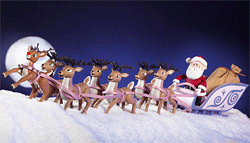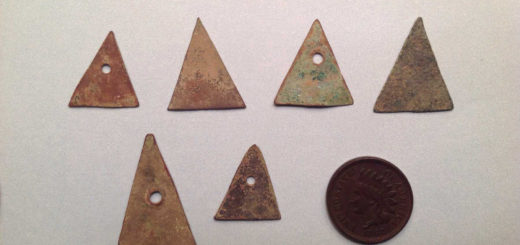Santa’s Reindeer as Model for the Evolution of Western Civilization
 There are eight traditional reindeer assigned to the sleigh that pulls Santa Claus during his annual ritual. After some consideration and study, I’ve determined that they are archetypes, assigned in an order to convey a very important message about the development of certain aspects of Western civilization, rather than merely being convenient arrangements for holiday music and poetry.
There are eight traditional reindeer assigned to the sleigh that pulls Santa Claus during his annual ritual. After some consideration and study, I’ve determined that they are archetypes, assigned in an order to convey a very important message about the development of certain aspects of Western civilization, rather than merely being convenient arrangements for holiday music and poetry.
I’ll start with those nearest the sleigh as they are symbolically the first and oldest. This pair would be Donner and Blitzen. These Nordo-Germanic reindeer are blatantly pre-Christian, and they hearken to the earliest stages of the sled model. Donner is a degeneration of Donder which is German for “Thunder”. His rein-mate is Blitzen which is derived from the German word for “Lightning”. Consider and compare the goat-pulled chariot of Thor of the Norse pantheon. Can you say, Santa Thor?
Moving forward in the arrangement and in time we find the reindeer pair Comet and Cupid. Cupid needs little explanation as she (yes, Cupid is a female reindeer) is drawn directly from the Roman pantheon. Comet is almost certainly a reference to the celestial object/event witness by Emperor Constantine during the Battle of the Milvian Bridge. This event resulted in Christianity becoming the official religion of the Roman Empire. From this, we can see that Comet and Cupid represent the sleigh moving into a Christian era.
This brings us to Prancer and Vixen in the harness order. Prancer is renowned for his raw strength and power, while his twin Vixen is known for her wild beauty and swiftness. Although not clear cultural icons, the very indistinct nature of these two reindeer makes it obvious to me that they represent the emergence of strong, yet less sophisticated cultures during the decline of the Roman Empire. Prancer and Vixen are our bridge to and throughout the so-called Dark Ages, where while civilization regressed somewhat, the continent received a much needed infusion of vigor that would eventually fuel its advancement.
The last of the two traditional reindeer are Dasher and Dancer. Dasher is renowned for his speed and prowess at travel, while Dancer is a refined beauty and sophisticated creature. Between the two of them they represent the Age of Enlightenment through the colonial period. Fueled by trade and travel, Europe enjoyed a blossoming (Dasher) as well as an emergence of new leisure pursuits and broadening of social classes (Dancer).
And what examination would be complete without Rudolph, the so-called “Red Nosed Reindeer”. While the previous reindeer at least emerge under the pretext of tradition and mythic evolution, Rudolph was the intentional and systematic invention of a marketing campaign. In this regard, Rudolph symbolizes our own modern era.
Hope you’ve enjoyed this little examination and I’m sorry I haven’t gone into more depth but feel free to discuss and/or expand in the comments section.








Beautiful. I can find no flaw in your analysis.
That is a historical first! Woot!
I would disagree with your depiction of Prancer and Vixen. Clearly they call to the more enlightened times post dark ages. The names bring to mind more of the renaissance with Prancer depicting the art and culture we associate with the period and Vixen, in fact, reflecting the cultural impact of the courtesans of 16th century Venica
I would disagree with your depiction of Prancer and Vixen. Clearly they call to the more enlightened times post dark ages. The names bring to mind more of the renaissance with Prancer depicting the art and culture we associate with the period and Vixen, in fact, reflecting the cultural impact of the courtesans of 16th century Venice.
I can tell you feel very strongly about this… possibly twice as strongly. 🙂